How To Choose the Perfect Power Bank for Travel
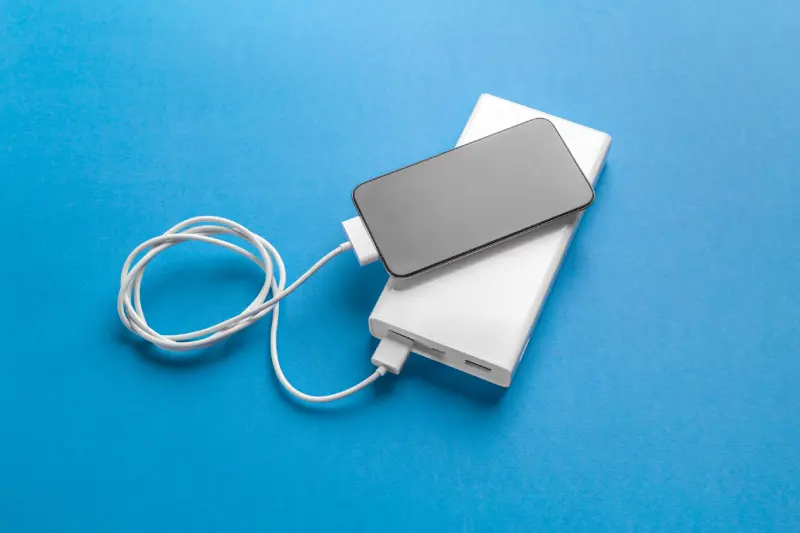
Table of Contents
ToggleImagine camping in the middle of a forest, when you glance at your phone—15% battery left. What would you do? Panic, plan, or just accept the situation? If you are an avid traveler, keeping your mobile charged is one of the biggest concerns. Nothing can ruin a trip more than a dead phone or camera. Whether you need maps to navigate a new city, capture memories, or stay connected, having your mobile device is essential. And when you’re traveling, ensuring it stays charged is key. In such a situation, a reliable power bank can be your lifesaver.
This small portable device has the power to charge up your device battery within minutes without any power socket. But with so many options and sizes available, it’s difficult to choose the perfect power bank, especially for travel. Mobile usage during travel is high; therefore, choosing a reliable power bank with good battery capacity is crucial. In this blog, we will share a complete guide on choosing the perfect power bank for travel for staying connected.
Factors to Consider While Choosing a Perfect Power Bank for Travel
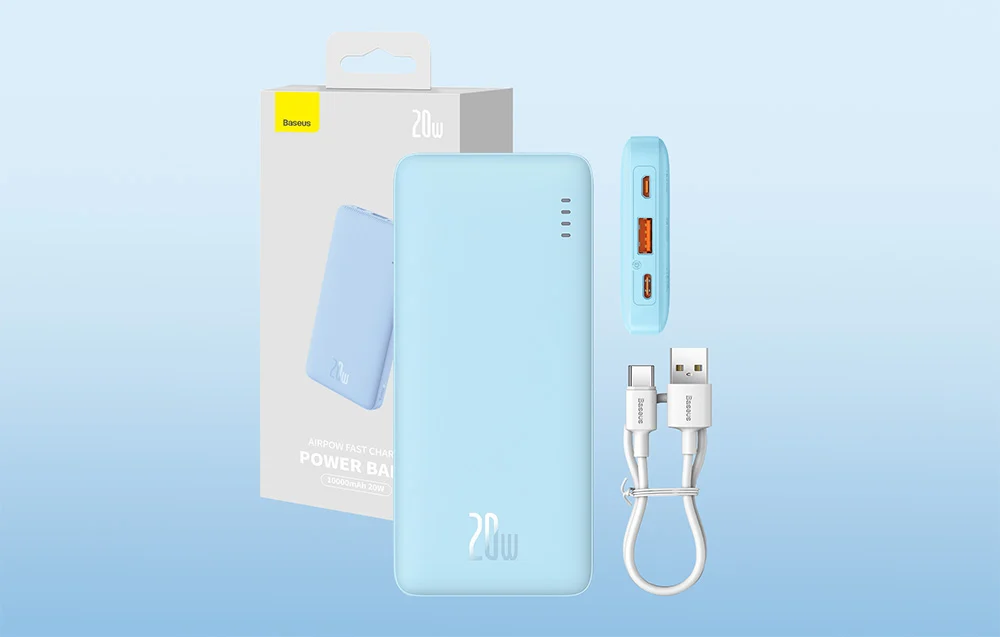
Choosing the perfect power bank can be a challenging task due to so many options available in the market. For traveling, a power bank should be lightweight and compact, have high battery capacity, and offer fast charging. Have a look at some important factors to consider when choosing the right power bank for travel:
Number of Devices
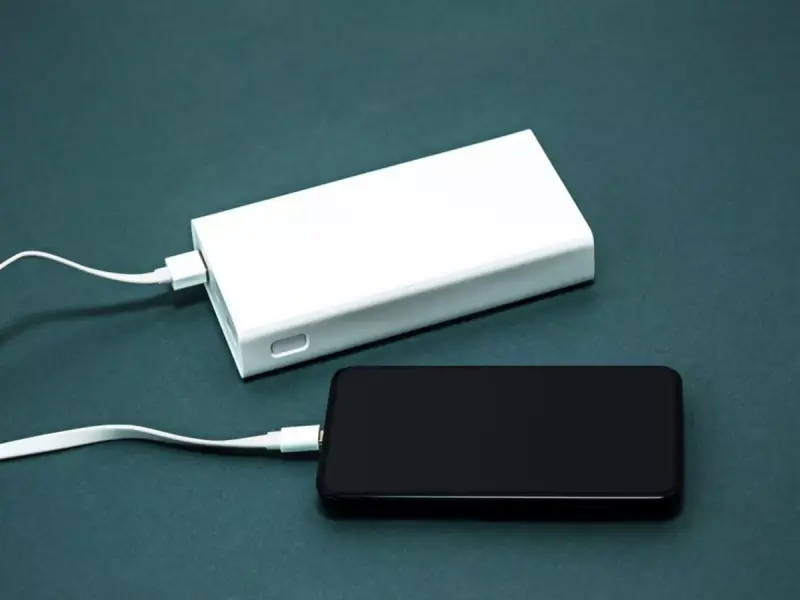
Consider how many devices you are going to charge in a single day with a power bank. Devices can include smartphones, tablets, cameras, headphones, etc. Also check each device’s battery size; the larger the battery, the more power and capacity it requires to charge. If you have more devices or need to charge your device repeatedly, a high-capacity power bank is required. A high-capacity power bank is ideal if you rely on your devices throughout the day or use them heavily.
Battery Capacity
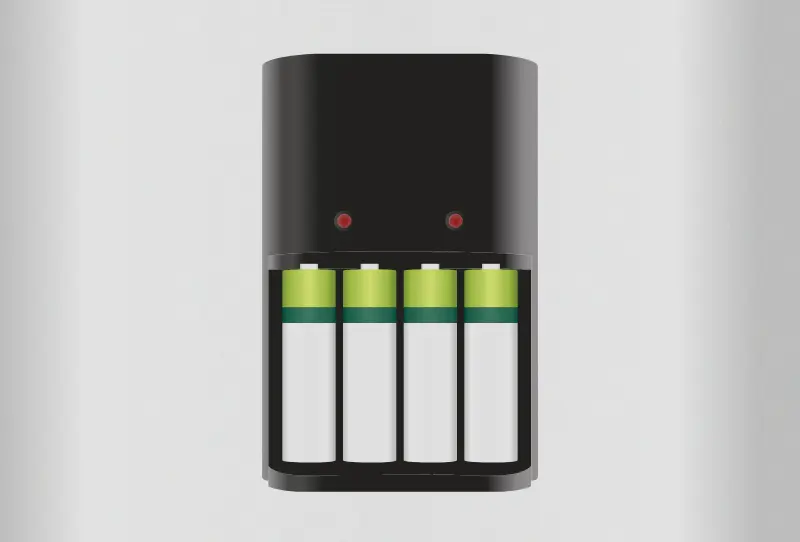
Battery capacity is how much charge or power the power bank can store and deliver to the device. The amount of power it can hold ultimately decides how many times it can charge your device. Battery capacity is measured in milliampere-hours (mAh). To find the right battery capacity, simply multiply the total device battery capacity (mAh) by the number of charges you’ll need per day.
A power bank with high battery capacity can charge your device multiple times whereas a low battery one can charge only once or twice. For travel needs where a smartphone and camera require charging, a battery capacity of 5000mAh – 15000mAh is sufficient. Have a look at different battery capacities for power banks:
5,000 mAh to 10,000 mAh: Perfect for short trips and day-long outings, this battery capacity is a good balance between size and power. A 5000mAh can charge a mobile twice, whereas a 10,000mAh can charge thrice. These sizes are small and can easily fit in a pocket. However, this battery range may not fully charge larger devices like laptops.
10,000 mAh to 20,000 mAh: This is a great middle ground, best for longer trips, especially when you need to keep multiple devices powered. A power bank with 20,000 mAh can charge a smartphone multiple times and even other devices, including tablets and laptops. Although they are a bit bulkier and heavier, they offer great battery life for many days.
20,000mAh or more: These power banks are useful for users with high charging demands or are planning an extended remote travel. They can power multiple devices like phones, tablets, drones, camera, laptop, etc., at once and charge them fully. They are quite bulky and may not be allowed for air travel due to restrictions on power banks (above 27,000mAh).
Size, Weight, and Portability
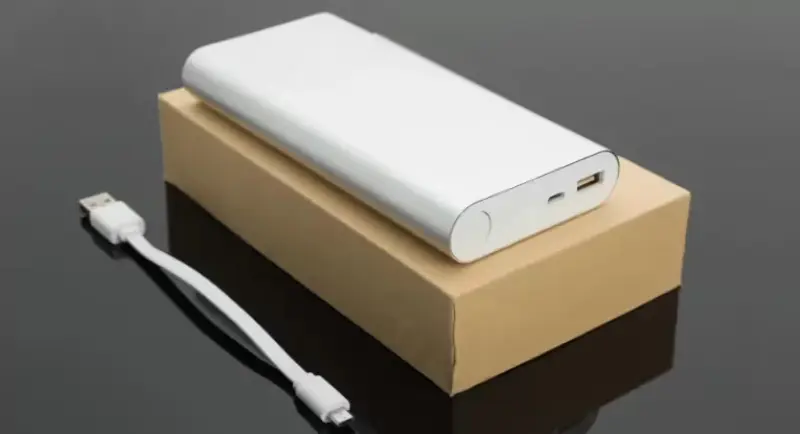
Traveling light is important; therefore, choosing a portable power bank to easily carry it while traveling is crucial. To do that, consider the size, weight, and portability of the power bank. Choose the one that is sleek, lightweight, compact, easy to carry, and won’t take up much space in your bag.
Now, the problem is the size and weight of the power bank increase with the increase in mAh capacity. Large capacity means heavier power banks that are difficult to go for in most pockets, especially while traveling. Therefore, striking a balance between portability and capacity is important to choose the right power bank for travel.
If you are looking to charge your phone just once or twice a day, you can go for a pocket-sized model with around 8000-10,000 mAh. It is a perfect balance of lightweight and required capacity that can fit into a pocket, purse, or bag. However, for a backpacking, hiking, or camping trip, a large capacity power bank with 10,000 mAh to 20,000 mAh is required. In that situation, you need extra space in a backpack or briefcase to keep the power bank.
Charging Speed
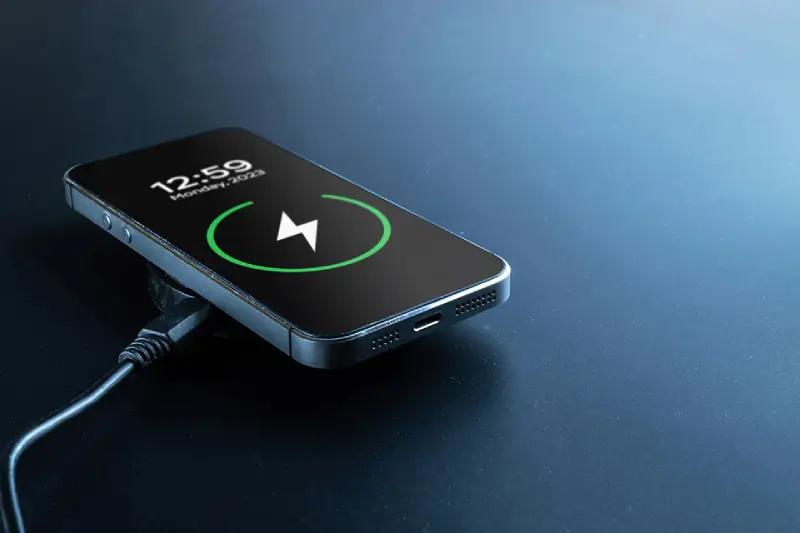
When choosing a power bank for travel, consider its charging speed to ensure your device powers up quickly. Charging speed is the amount of power it delivers to your device to charge it. You don’t want to be waiting too long to get your device powered up, therefore it’s best to choose the one with fast charging support. Consider picking the one with Quick Charge or USB Power Delivery, which provides a higher voltage to charge fast. These features allow charging your device faster, saving you precious time during the trip. For example- USB-C Power Delivery can charge your phone to half in just 30 minutes, which is great for layovers or on the go.
It is important to note that the power bank output needs must meet the requirements of your device. If the output matches or exceeds, your device can charge fast while in use, whereas if it’s less, your device won’t charge while in use. Therefore, check the output wattage while selecting the right power bank for travel. A power bank with 18W or more is recommended for smartphones, whereas 30W or higher is recommended for tablets or laptops.
Device Compatibility

Checking device compatibility is one of the most important factors to consider when choosing the perfect power bank for travel. Some power banks have different cables, low voltage, or wattage that may not go with your device. Therefore, it’s important that the USB port or the portable cable of the power bank is compatible with your device.
Along with that, the voltage or wattage should also be compatible with the power required by your devices. Have a look at different types of ports in power banks for different devices:
USB A: The standard rectangular port is shaped for most older devices and is widely compatible with existing cables.
USB-C: The most common and popular port type, preferred for newer smartphones, tablets, and laptops. They offer faster charging and have high data transfer speeds.
Micro-USB: Common in older smartphones and some portable devices but becoming less prevalent.
Lightning: Some power banks come with built-in lightning cables specific to Apple devices like iPhones and iPads.
Wireless: Some of the latest and most advanced power banks have wireless chargers that let you charge your device by placing it on the power bank.
Number of Ports
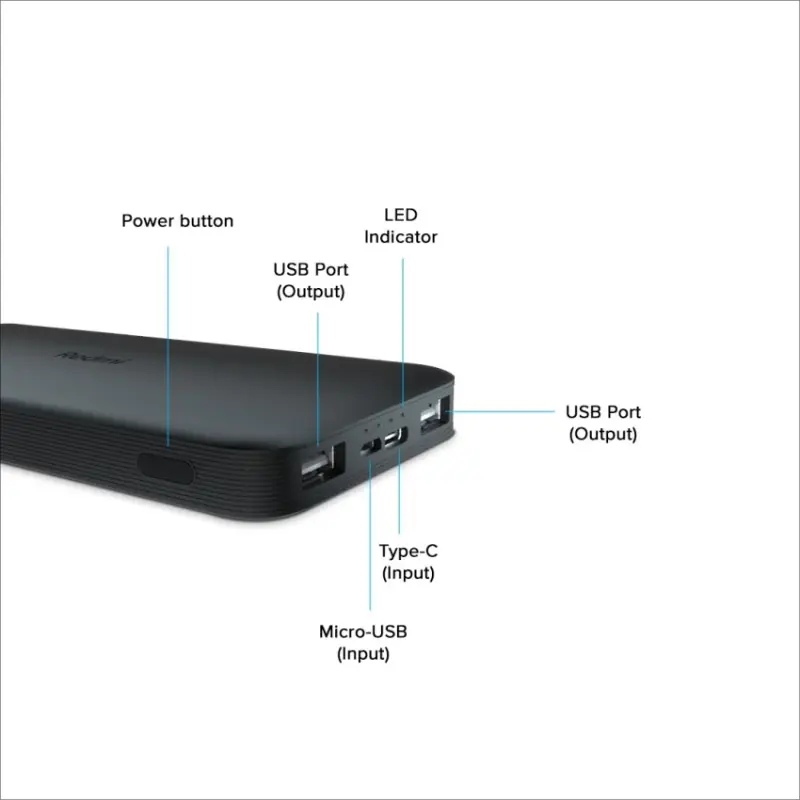
While traveling, we carry a number of devices including smartphones, camera, tablet, smartwatch, headset, drone, etc. It is possible that you may need to charge more than one device at the same time. For such situations, considering the number of ports is crucial. There are two types of power bank ports – single and multiple. Have a look at both of them in detail:
Single-Port Power Banks: Single-port power banks are compact, lightweight, and designed for light travelers who need to charge less. They have only one USB port, making them ideal for people who charge one device at a time. However, their power capacity is less (5000-10,000mAh), which means they are useful only for day trips or short travel.
Multi-Port Power Bank: Power banks with multiple ports are great for charging multiple devices at once. They have a battery capacity of 10,000 mAh to 20,000 mAh, meaning they can charge more devices multiple times. With two or more ports, they are ideal for heavy travelers who require charging their mobile, camera, tablet, etc., simultaneously. It’s best to go for a mix of USB-A and USB-C ports to accommodate various cables and devices.
Built-in Cables
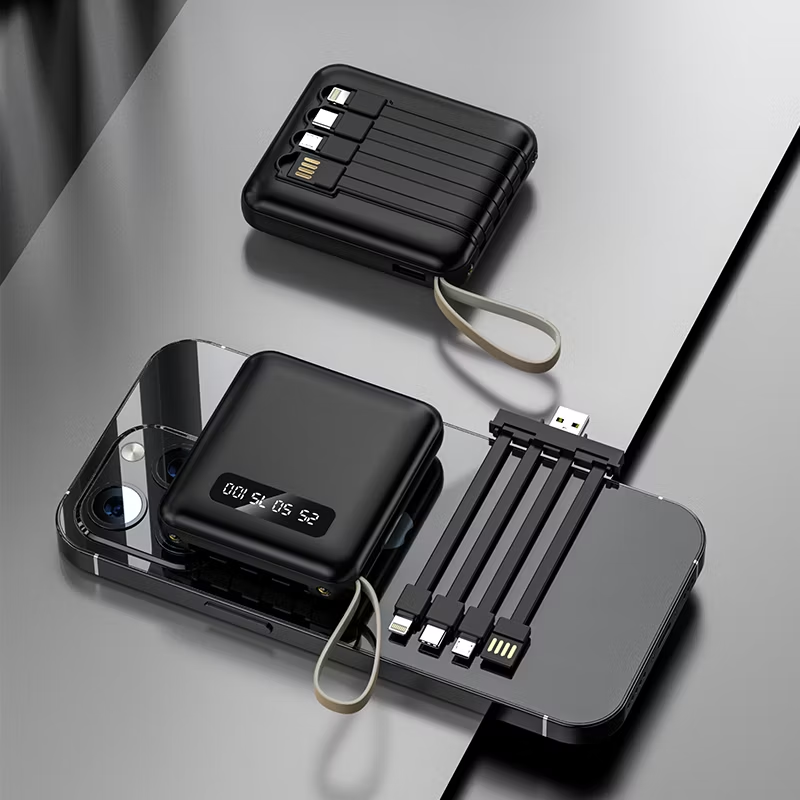
Another important factor to consider when choosing the perfect power bank for travel is the built-in cables. Carrying the necessary cables for every device is crucial to charging them and forgetting even a single one can ruin your trip. Therefore, it’s better to choose power banks with built-in cables. Such power banks have fixed cables of different types that you can use to charge your devices without any external cable. You don’t need to worry about forgetting or misplacing the cables so that you can enjoy your trip to the fullest.
Some of the latest power banks even have retractable and length-adjustable cables, making them compact and easy to store. The cables remain inside the power bank until you pull them out, eliminating the chances of damage or tangling. Therefore, it’s best to choose power banks with adjustable built-in cables so that you can use them whenever you need.
Take it on A Plane
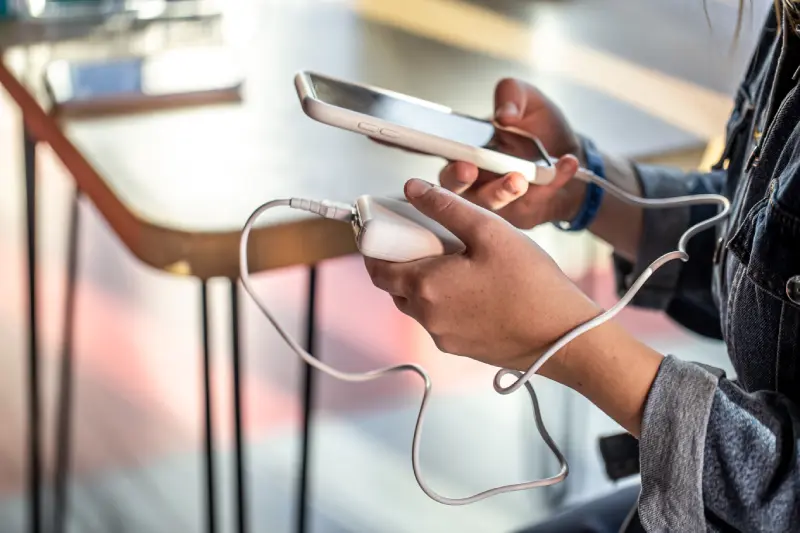
If you are planning to travel by plane, you must know that power banks are prohibited in checked luggage. However, you can carry power banks with a capacity of up to 27,000mAh (100Wh) in your carry-on luggage. For power banks between 100Wh and 160Wh, airline approval is required. This means if you are traveling by plane, no matter how much capacity you require, you have to stick to a maximum of 27000mAh. If you have to carry a power bank of more capacity, make sure to inform the airline in advance and get their approval. If you don’t, your power bank will be separated from your luggage, and you won’t be able to take it on board.
Note that a power bank of 20,000-25,000 mAh is enough to charge a smartphone more than six times a day. It can also easily charge other devices such as tablets, laptops, smartwatches, cameras, etc. Therefore, you can easily go for a 20,000 mAh or less capacity power bank for seamless air travel.
Durability

Durability is an important factor to consider especially when you are purchasing a power bank for travel. During traveling, a power bank can be subject to more wear and tear due to the bumps and hassles of a journey. To withstand that, choosing a durable and strong power bank that can handle such rough usage is crucial. Consider the following features while checking the durability of the power bank:
Material: Look for power banks made with high-quality, sturdy materials like rugged plastic, aluminum, or stainless steel. These materials are resistant to drops, impacts, scratches, and basic wear and tear.
Shockproof Design: Choose power banks with a shockproof or rugged design to absorb shock during rugged outdoor trips and adventures. Consider the ones with a rubberized finish, as they provide extra shock resistance.
Water Resistance: Outdoor enthusiasts should go for a dustproof and waterproof power bank that can withstand diverse environments and weather conditions. Choose the one with IP67 or higher as they provide great water resistance and protect them from moisture or dirt.
Safety Features

Safety should be your topmost priority; therefore, consider the safety features carefully when choosing a safe and reliable power bank. Considering the safety features not only protect your device but also provide you complete peace of mind. Look for these important safety features when you choose the perfect power bank for travel:
Overcharge Protection: This feature prevents the power bank from overcharging the connected devices, ensuring device safety and battery health.
Short-Circuit Protection: This feature automatically cuts off power in case of a short circuit, preventing any accidents.
Temperature Control: Prevent the power bank from overheating during charging or discharging, thus maintaining its battery health.
High-Quality Battery: Battery quality with grade A is safer than others and is less likely to cause a fire or explode.
Brand, Quality, and Warranty
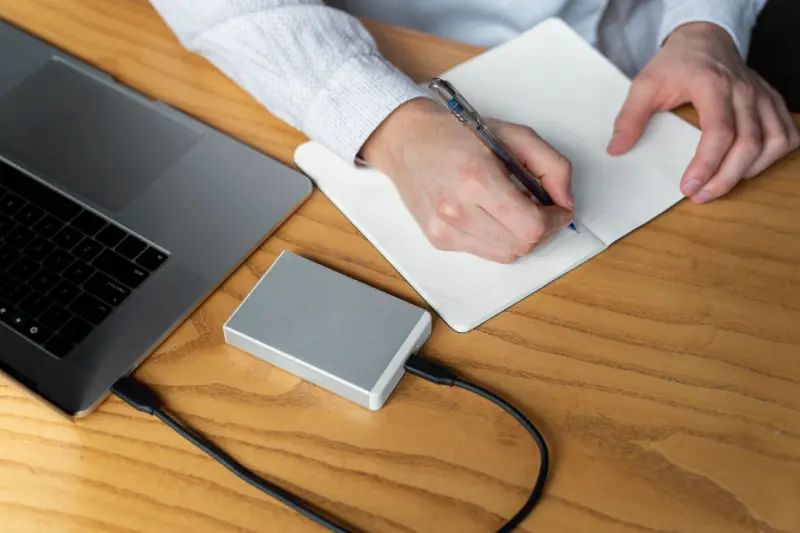
When choosing a power bank for traveling, it’s crucial to consider the brand, quality, and warranty. The power bank will charge your devices and help you stay connected with the world. So, choose a high-quality power bank from the right brand that offers a proper warranty to get long-term value and ensure durability.
Brand Reputation: Do market research and choose a reputable brand that has been present in the market for some years. Established brands offer high-quality power banks and adhere to strict manufacturing standards. They also offer reliable customer support and a warranty in case of any issues. To choose the right brand, make sure to check reviews on platforms like Amazon, Best Buy, etc., to gauge their services.
Quality: Choose a high-quality power bank to ensure efficiency, longevity, and safety. Cheap or low-quality power banks can be damaged due to minor shocks and scratches and are more prone to failure. Look for power banks made from durable materials like ABS plastic or aluminum alloy. Choose the power banks with lithium-polymer batteries as they are much safer and more reliable than lithium-ion batteries.
Warranty Coverage: Consider a brand that offers a robust warranty, which indicates that the manufacturer stands by the product quality. Most power banks come with a one-year warranty, which basically covers manufacturing defects. However, if your travel plans are more adventurous, it’s better to opt for an extended warranty of 2-3 years. In this, everything from ports and cables to external casing and battery issues is covered.
Conclusion
Power banks truly are a traveler’s best friend, keeping your devices like phones, watches, tablets, and cameras juiced up during those long trips. Choosing the right one doesn’t have to be overwhelming; just remember the two key factors: device compatibility and battery capacity. Beyond that, think about practical aspects like size, weight, durability, number of ports, and safety features. By keeping these points in mind, you’ll find a power bank that’s not just convenient but also reliable, ensuring your devices stay powered up and ready for every adventure.
Author
Book your fondest memory here
Popular Posts
Best Family-Friendly Beaches in Florida
With its pristine beaches and warm waters, Florida is a…
Best Beaches in Florida: From Clearwater to South Beach
Florida is a beach lover’s paradise, and that’s no exaggeration.…
Best Places to Visit in Florida During Winter
Winter is the perfect time to step away from the…
Categories
- Best Places (25)
- Destinations (26)
- Experiences (21)
- Photography (1)
- Travel (48)
- Travel Products (7)
- Trip Style (8)
Search With Tags
Join Our Newsletter
Get Your Daily
Dose
Of Travel Inspiration
"*" indicates required fields


